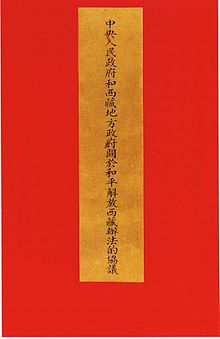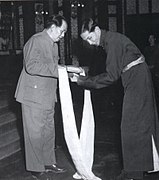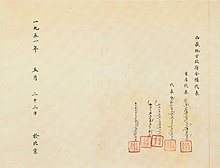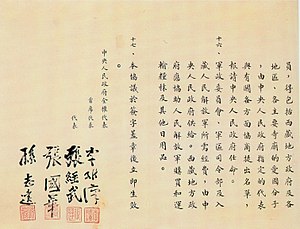| Agreement of the Central People's Government and the Local Government of Tibet on Measures for the Peaceful Liberation of Tibet | |||||||||||
 | |||||||||||
| Chinese name | |||||||||||
|---|---|---|---|---|---|---|---|---|---|---|---|
| Traditional Chinese | 中央人民政府和西藏地方政府關於和平解放西藏辦法的協議 | ||||||||||
| Simplified Chinese | 中央人民政府和西藏地方政府关于和平解放西藏办法的协议 | ||||||||||
| |||||||||||
| Seventeen Point Agreement | |||||||||||
| Traditional Chinese | 十七條協議 | ||||||||||
| Simplified Chinese | 十七条协议 | ||||||||||
| |||||||||||
| Tibetan name | |||||||||||
| Tibetan | བོད་ཞི་བས་བཅིངས་འགྲོལ་འབྱུང་ཐབས་སྐོར་གྱི་གྲོས་མཐུན་དོན་ཚན་བཅུ་བདུན་ | ||||||||||
The Agreement of the Central People's Government and the Local Government of Tibet on Measures for the Peaceful Liberation of Tibet, or the Seventeen Point Agreement for the Peaceful Liberation of Tibet for short, is the document by which the delegates of the 14th Dalai Lama, sovereign of the de facto state of Tibet, reached an agreement in 1951 with the Central People's Government of the newly established People's Republic of China on affirming Chinese sovereignty over Tibet.

The 14th Dalai Lama, religious name: Tenzin Gyatso, shortened from Jetsun Jamphel Ngawang Lobsang Yeshe Tenzin Gyatso; born Lhamo Thondup, is the current Dalai Lama. Dalai Lamas are important monks of the Gelug school, the newest school of Tibetan Buddhism which was formally headed by the Ganden Tripas. From the time of the 5th Dalai Lama to 1959, the central government of Tibet, the Ganden Phodrang, invested the position of Dalai Lama with temporal duties.
In law and government, de facto describes practices that exist in reality, even if not officially recognised by laws. It is commonly used to refer to what happens in practice, in contrast with de jure, which refers to things that happen according to law. Unofficial customs that are widely accepted are sometimes called de facto standards.

The polity of Tibet from 1912 to 1951 came into being in the aftermath the collapse of the Qing dynasty in 1912, and lasted until the incorporation of Tibet into the People's Republic of China by the People's Republic of China. The Tibetan Ganden Phodrang regime was Protectorate of the Qing until 1912, when the Provisional Government of the Republic of China replaced the Qing dynasty as the government of China, and signed a treaty with the Qing government inheriting all territories of the previous dynasty into the new republic, giving Tibet the status of a "Protectorate" with high levels of autonomy as it was Protectorate under the dynasty. At the same time, Tibet was also a British Protectorate. However, at the same time, several Tibetan representatives signed a treaty between Tibet and Mongolia proclaiming mutual recognition and their independence from China, although the Government of the Republic of China did not recognize its legitimacy. With the high levels of autonomy and the "proclaiming of independence" by several Tibetan representatives, this period of Tibet is often described as "de facto independent", especially by some Tibetan independence supporters, although most countries of the world, as well as the United Nations, recognized Tibet as a part of the Republic of China.
Contents
- Lead-up
- Agreement
- The seventeen points
- Negotiations
- Signing of the Agreement
- Full text of the agreement
- Repudiation of the Agreement
- See also
- References
- Citations
- Sources
- External links
Chinese sources regard the document as a legal contract that was mutually welcomed by both governments as well as by the Tibetan people. Central Tibetan Administration which was formed after 1960, and international law expert Eckart Klein, consider it invalid and as having been signed under duress. [1] [2] However, Ngapoi Ngawang Jigme, head of the Tibetan Delegation to the Beijing Peace Negotiations, reports that there was no duress involved when he signed the agreement. [3]

The Central Tibetan Administration, also known as CTA is an organisation based in India. It was originally called Tibetan Kashag Government in 1960, then later renamed to "the Government of the Great Snow Land". The CTA is also referred to as the Tibetan Government in Exile which has never been recognized by China. Its internal structure is government-like; it has stated that it is "not designed to take power in Tibet"; rather, it will be dissolved "as soon as freedom is restored in Tibet" in favor of a government formed by Tibetans inside Tibet. In addition to political advocacy, it administers a network of schools and other cultural activities for Tibetans in India. On 11 February 1991, the CTA became a founding member of the Unrepresented Nations and Peoples Organization (UNPO) at a ceremony held at the Peace Palace in The Hague, Netherlands.

Ngapoi Ngawang Jigme was a Tibetan senior official who assumed various military and political responsibilities both before and after 1951. He is often known simply as Ngapo in English sources.
The United States informed the Dalai Lama in 1951 that in order to receive assistance and support from the United States, he must depart from Tibet, publicly disavow the Agreement and conclude that duress was involved between the representatives of Tibet and China. [4]


































